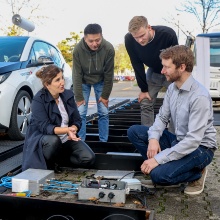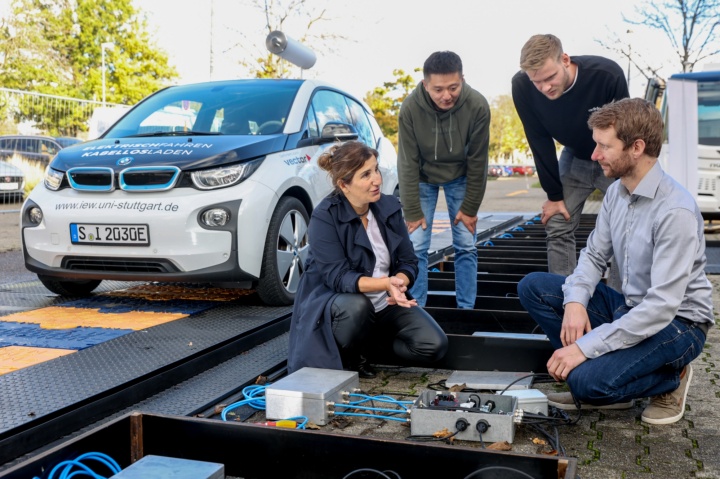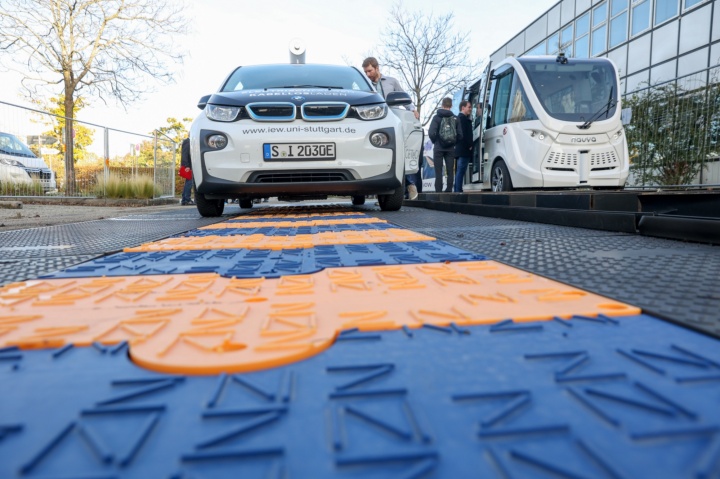The test track on the campus of the University of Stuttgart is 20 m long. There, e-vehicles can be charged inductively while driving – with an incredible efficiency that has never been achieved before. The test track was developed by a research team from the Institute for Electrical Energy Conversion (IEW) under the leadership of Director Professor Nejila Parspour as part of the MobiLab sub-project “Forschungsstraße: Dynamisches Laden und sichere Energieversorgung”.
Charge while driving, instead of long downtimes attached to a cable: “Thanks to dynamic charging, we can extend the range of the vehicles, reduce the battery capacity, and drastically reduce the necessary charging time,” explains Parspour. What is special about the test track at the University of Stuttgart is that efficiencies of more than 90% can be achieved. The efficiency is thus on par with conductive charging with a cable. “With this high level of efficiency, we have reached a milestone in inductive dynamic charging. We don’t know of any system that is as efficient,” says Parspour, who is overseeing the project together with Professor Krzysztof Rudion of the Institute of Power Transmission and High Voltage Technology (IEH).
How does dynamic inductive charging work?
The test track on the Vaihingen campus consists of 40 individual coil elements with a surface area of 50 × 48 cm. The distance between the vehicle and the coils is 20 cm. The track automatically detects the position of the vehicle above the coil system and supplies only the relevant primary coils. Energy is transferred through the magnetic coupling to the secondary coil in the vehicle. The power transferred is proportional to the area of the secondary coil. With the same surface area of 0.24 m2, a power of 10 kW is continuously transmitted regardless of vehicle speed. For comparison: A conventional power outlet provides 2.3 kW of continuous power to charge an e-car. Overall, the test track provides constant and uninterrupted power transmission while driving.
Many advantages for autonomous vehicles
Especially for autonomous vehicles such as shuttle vehicles, inductive charging tracks offer considerable advantages. This would allow the vehicles to be in operation around the clock with no downtime during the charging. Next Parspour and her team will test the technology on the autonomous CampusShuttle at the University of Stuttgart. This is currently being trained. The test track is to be expanded into a research road on the Vaihingen campus.
As part of the inductive dynamic charging project, Parspour and her team plan to further explore bidirectional charging. This would allow the vehicles to be used as energy buffers, for example. The scientists would also like to further increase the power density (i.e., the energy transfer capacity per journey).
About MobiLab
The test track for inductive and dynamic charging is a sub-project of the MobiLab Real-World laboratory. The aim is a car-free campus. In addition to the topic of inductive charging while driving, a team led by Professor Frank Allgöwer is developing an autonomous e-scooter, and a research group led by Dr. Dan Greiner is conducting research on an autonomous CampusShuttle.
Media representatives are cordially invited to view the test track on site. If you are interested, please feel free to contact Professor Nejila Parspour.
Expert Contact:
Prof. Nejila Parspour, University of Stuttgart, Institute of Electrical Energy Conversion, phone: +49 711 685-67819, e-mail




